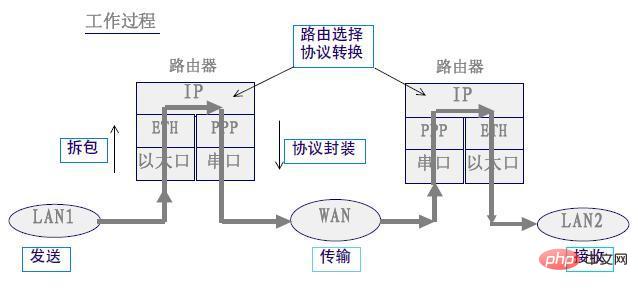
With the development of the Internet, the commonly used network interconnection method in households is "host-router". A router is a hardware device that connects two or more networks. It is a specialized intelligent network device that reads the address in each data packet and then decides how to transmit it. The router can analyze the destination addresses of data packets from different types of networks, convert addresses from non-TCP/IP networks into TCP/IP addresses, or vice versa; and then transmit each data packet to the destination on the best route based on the selected routing algorithm. Specify location. So the router can connect non-TCP/IP networks to the Internet.

The operating environment of this tutorial: Windows 7 system, Dell G3 computer.
With the development of the Internet, the commonly used network interconnection method in households is "host-router".
A router is a hardware device that connects two or more networks. It acts as a gateway between networks. It is a dedicated intelligence that reads the address in each data packet and then decides how to transmit it. network equipment. It can understand different protocols, such as the Ethernet protocol used by a local area network and the TCP/IP protocol used by the Internet. In this way, the router can analyze the destination addresses of data packets from various types of networks, convert the addresses of non-TCP/IP networks into TCP/IP addresses, or vice versa; and then classify each data packet according to the selected routing algorithm. Deliver the best route to the specified location. So the router can connect non-TCP/IP networks to the Internet.
The router is the main node device of the Internet. Routers decide the forwarding of data through routing. The forwarding strategy is called routing, which is where the name of the router comes from. As the interconnection hub between different networks, the router system forms the main body of the Internet, an international Internet based on TCP/IP. It can also be said that routers form the skeleton of the Internet. Its processing speed is one of the main bottlenecks of network communication, and its reliability directly affects the quality of network interconnection. Therefore, router technology has always been at the core in campus networks, regional networks, and even the entire Internet research field, and its development history and direction have become a microcosm of the entire Internet research. At a time when my country's network infrastructure and information construction are in the ascendant, this paper discusses the role, status and development direction of routers in interconnection networks, as well as the domestic network technology research and network construction, as well as the clear understanding of routers and network interconnection in the network market. Various specious concepts have important significance.
Functions of routers
The main function of routers can be understood as the transfer of information. Therefore, we call this process the addressing process. Because the router is between different networks, it is not necessarily the final receiving address of the information. So in a router, there usually is a routing table. According to the final address of the information transmitted by the transmitting website, find the next forwarding address and which network it should be. In fact, to put it in a nutshell, it is like a courier company sending emails. The mail does not arrive at the final destination instantly. Instead, it is sorted at different substations and continuously approaches the final address, thereby realizing the mail delivery process. The router addressing process has a similar principle. Through the final address, a match is made in the routing table, and the next forwarding address is determined algorithmically. This address may be an intermediate address or the final destination address.
The function of a router is to transmit data between different subnets. The specific functions are as follows:
(1) Realize the interconnection of IP, TCP, UDP, ICMP and other networks.
(2) Process the data. It can send and receive data packets and has various functions such as packet filtering, multiplexing, encryption, compression and protection wall of data.
(3) Select the next transmission destination of the data packet based on the information in the routing table.
(4) Exchange topology information between the external gateway protocol and other autonomous domains.
(5) Implement network management and system support functions.

For more related knowledge, please visit the FAQ column!
The above is the detailed content of With the development of the Internet, what are the commonly used network interconnection methods in families?. For more information, please follow other related articles on the PHP Chinese website!
 Computer Languages
Computer Languages
 What are the functions of computer networks
What are the functions of computer networks
 Computer application areas
Computer application areas
 The most prominent features of computer networks
The most prominent features of computer networks
 Characteristics of the network
Characteristics of the network
 What is the encoding used inside a computer to process data and instructions?
What is the encoding used inside a computer to process data and instructions?
 The main reason why computers use binary
The main reason why computers use binary
 What are the main characteristics of computers?
What are the main characteristics of computers?